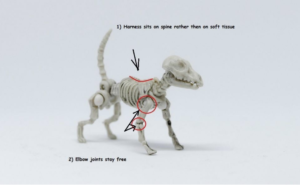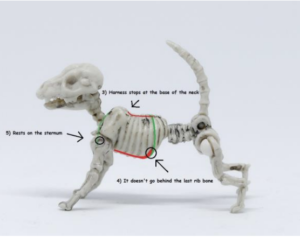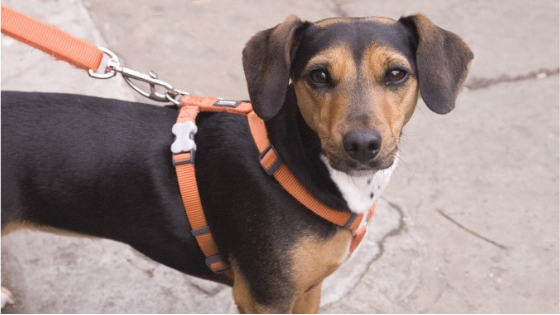by Beatrix Beri, CPDT-KA, UW-AAB.
If you’ve ever been down the long aisle of various harnesses at a pet store, you likely experienced the overwhelming feeling that often pairs with purchasing a dog harness.
As a formal dog walker and currently a dog trainer, I used to take many dogs for walks regularly. These dogs were all different sizes, with various temperaments and wide age ranges, which hugely influences dogs’ behavior on walks, and how they relate to being on a leash. While one dog would try to escape from his harness, another would refuse to get in it. Some dogs were chronic squirrel chasers, while others were overly friendly and excitable. Most dog owners rely on body harnesses to equip their dogs for outside activity. The harness (if placed correctly) puts less pressure on the dog’s body, unlike the classic collar-leash combination. The result is a more comfortable walk for your excited, prey chasing, or pulling young pooch. Senior and low-energy level dogs can still have a chill walk using the collar-leash combo. Best if they get a break from the entire harness fitting-securing ceremony altogether.
What’s Up with the Collar?
Collars provide no control over your dog’s movement when you attempt to redirect or stop them. If we rely on the pressure, we place on a leash to coordinate our dogs, we could potentially damage their trachea and neck area. Breeds like French Bulldogs with short snouts should be walked with a body harness. Their airways are more closed, and the airflow is more limited than long-snouted dogs. Unless we are walking a senior, low-energy, or highly trained dog, we will, at some point, experience the toughness of a squirrel chaser. However, a well-chosen harness offers lots of benefits to both you and your dog, minus the risks of an injury.
So, What Makes a Harness Good for Your Dog?
The correct harness follows your dog’s body structure while allowing them a maximum range of body movements while walking, running, or even sprinting. The proper fitting provides better handling for you, but it prevents your dog from escaping. There are a variety of harnesses on the market you can choose from, and it can be overwhelming to find the right one. Luckily, we gathered a few key points for you to focus on when shopping for the right one.
Attachment Points
 A harness with many attachment points helps make sure the harness is fitted to your dog’s body correctly. While on, the straps should be tight enough around the waist so it will not slide to either side. Harnesses with front and back clip rings are beneficial for large dogs or heavy pullers. Attaching a leash both upfront and in the back gives you more control over your dog’s body without applying pressure to sensitive joints or muscle points. Your dog’s body also stays balanced during the walk. It is important to fit the bulk of the material to sit on your dog’s spine instead of soft tissue, especially if the attachment points are secured with a thick clip. Be sure to try on your dog harnesses that leave the elbow joints free to avoid unnecessary pressure during your dog’s movements.
A harness with many attachment points helps make sure the harness is fitted to your dog’s body correctly. While on, the straps should be tight enough around the waist so it will not slide to either side. Harnesses with front and back clip rings are beneficial for large dogs or heavy pullers. Attaching a leash both upfront and in the back gives you more control over your dog’s body without applying pressure to sensitive joints or muscle points. Your dog’s body also stays balanced during the walk. It is important to fit the bulk of the material to sit on your dog’s spine instead of soft tissue, especially if the attachment points are secured with a thick clip. Be sure to try on your dog harnesses that leave the elbow joints free to avoid unnecessary pressure during your dog’s movements.
Symmetry
 Symmetrically placed attachment points help to avoid unbalance and harness rotation. The straps or buckles should be symmetrical on all sides and meeting points. Check them all!
Symmetrically placed attachment points help to avoid unbalance and harness rotation. The straps or buckles should be symmetrical on all sides and meeting points. Check them all!
Limited rigid spots
Be sure to avoid big buckles to ensure your dog is comfortable while wearing and moving around in the harness. Notice if they are hesitant to move around while wearing it. Another sign of intolerance is if they often stop in motion to nip at it.
Conclusion
Look for a harness that is durable enough to hold up if you are working with a pulling dog. Observe the attachment points and see if they are symmetrically all over. Skip the ones with thick or rigid buckles and spots that can be uncomfortable for your dog. The classic Y-shaped harness goes over the dog’s head, tends to meet all the criteria mentioned above, and there are many styles available to choose from with or without padding. If you notice your dog being reluctant to get into his harness, check to make sure the harness fits properly. Praise with many treats in a row while the harness is being put on or taken off. It will help get your dog to like his harness if he seems to be avoiding it! I hope you enjoyed this blog post and best of luck with finding the right one!
About the Author

Beatrix Beri‘s goal is to help future and current puppy, and adult dog handlers better understand their dog’s behavior and provide training solutions based on the most up-to-date animal behavior science. She is certified as a CPDT-KA through CCPDT and as a UW-AAB (University of Washington – Certificate in Applied Animal Behavior). Please contact her to learn more her background, philosophy and training style. She offers multi-session packages for in-person dog training and board & train for up to 10 days.


